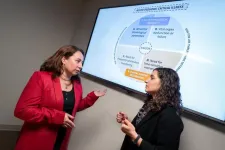(Press-News.org) Researchers from the Harvard John A. Paulson School of Engineering and Applied Sciences (SEAS) have developed a new lithium metal battery that can be charged and discharged at least 6,000 times — more than any other pouch battery cell — and can be recharged in a matter of minutes.
The research not only describes a new way to make solid state batteries with a lithium metal anode but also offers new understanding into the materials used for these potentially revolutionary batteries.
The research is published in Nature Materials.
“Lithium metal anode batteries are considered the holy grail of batteries because they have ten times the capacity of commercial graphite anodes and could drastically increase the driving distance of electric vehicles,” said Xin Li, Associate Professor of Materials Science at SEAS and senior author of the paper. “Our research is an important step toward more practical solid state batteries for industrial and commercial applications.”
One of the biggest challenges in the design of these batteries is the formation of dendrites on the surface of the anode. These structures grow like roots into the electrolyte and pierce the barrier separating the anode and cathode, causing the battery to short or even catch fire.
These dendrites form when lithium ions move from the cathode to the anode during charging, attaching to the surface of the anode in a process called plating. Plating on the anode creates an uneven, non-homogeneous surface, like plaque on teeth, and allows dendrites to take root. When discharged, that plaque-like coating needs to be stripped from the anode and when plating is uneven, the stripping process can be slow and result in potholes that induce even more uneven plating in the next charge.
In 2021, Li and his team offered one way to deal with dendrites by designing a multilayer battery that sandwiched different materials of varying stabilities between the anode and cathode. This multilayer, multi-material design prevented the penetration of lithium dendrites not by stopping them altogether, but rather by controlling and containing them.
In this new research, Li and his team stop dendrites from forming by using micron-sized silicon particles in the anode to constrict the lithiation reaction and facilitate homogeneous plating of a thick layer of lithium metal.
In this design, when lithium ions move from the cathode to the anode during charging, the lithiation reaction is constricted at the shallow surface and the ions attach to the surface of the silicon particle but don’t penetrate further. This is markedly different from the chemistry of liquid lithium ion batteries in which the lithium ions penetrate through deep lithiation reaction and ultimately destroy silicon particles in the anode.
But, in a solid state battery, the ions on the surface of the silicon are constricted and undergo the dynamic process of lithiation to form lithium metal plating around the core of silicon.
“In our design, lithium metal gets wrapped around the silicon particle, like a hard chocolate shell around a hazelnut core in a chocolate truffle,” said Li.
These coated particles create a homogenous surface across which the current density is evenly distributed, preventing the growth of dendrites. And, because plating and stripping can happen quickly on an even surface, the battery can recharge in only about 10 minutes.
The researchers built a postage stamp-sized pouch cell version of the battery, which is 10 to 20 times larger than the coin cell made in most university labs. The battery retained 80% of its capacity after 6,000 cycles, outperforming other pouch cell batteries on the market today. The technology has been licensed through Harvard Office of Technology Development to Adden Energy, a Harvard spinoff company cofounded by Li and three Harvard alumni. The company has scaled up the technology to build a smart phone-sized pouch cell battery.
Li and his team also characterized the properties that allow silicon to constrict the diffusion of lithium to facilitate the dynamic process favoring homogeneous plating of thick lithium. They then defined a unique property descriptor to describe such a process and computed it for all known inorganic materials. In doing so, the team revealed dozens of other materials that could potentially yield similar performance.
“Previous research had found that other materials, including silver, could serve as good materials at the anode for solid state batteries,” said Li. “Our research explains one possible underlying mechanism of the process and provides a pathway to identify new materials for battery design.”
The research is co-authored by Luhan Ye, Yang Lu, Yichao Wang, and Jianyuan Li. It was supported by the Department of Energy Vehicle Technology Office, the Harvard Climate Change Solutions Fund, and Harvard Data Science Initiative Fund.
END
Solid state battery design charges in minutes, lasts for thousands of cycles
Research paves the way for better lithium metal batteries
2024-01-08
ELSE PRESS RELEASES FROM THIS DATE:
Andalibi to receive funding for Perthera Tissue Bank
2024-01-08
Andalibi To Receive Funding For Perthera Tissue Bank
Ali Andalibi, Senior Associate Dean, College of Science, is set to receive funding for: "Perthera Tissue Bank."
FFPE samples from Perthera will be housed in the cold room in the Institute for Advanced Biomedical Research (IABR). The Principal Investigator, Co-Investigator, and the staff member will be checking on the samples on a regular basis to ensure that the samples are safely stored and that the storage conditions, such as temperature, are appropriate. ...
How did the bushpig cross the strait? A great puzzle in African mammal biogeography solved by genomics
2024-01-08
In the ongoing biodiversity crisis, large terrestrial animals are more threatened by extinction than any other group of organisms. The African continent holds an impressively intact large-mammal community, but there is still a lot we do not know about how these species evolved, became diverse and adapted to the changing climate and habitats. Many of these questions can be addressed by investigating the genomes and genetic variation across species.
New research, published in Nature Communications, uses genomics to answer ...
Acute pediatric critical illness definition enables global research
2024-01-08
(MEMPHIS, Tenn. – January 05, 2023) St. Jude Children’s Research Hospital investigators collaborated with a global group of acute pediatric critical illness experts to reach a consensus definition of the condition. Research on how to improve care in low- and middle-income countries has been stymied because conventional pediatric critical illness definitions are not applicable in these settings. The new, more universal definition, reached by consensus among researchers and clinicians from 40 countries, will enable scientists to study pediatric critical illness more universally, which should lead to improvements in patient outcomes ...
A new book provides a roadmap for food systems transformation in Kenya
2024-01-08
The past few years have seen Kenya, along with many other countries, confronted with multifaceted and compounding challenges. The disruptions caused by COVID-19, high levels of food price inflation, and environmental crises, such as locust infestations and droughts, have severely tested the resilience of Kenya’s food systems and the affordability of food for its citizens. Against this backdrop of challenges and ongoing demographic shifts, urbanization, and stagnating agricultural production, ...
High-quality nursing home dementia care is not only a matter of adding staff
2024-01-08
Irvine, Calif., Jan. 8, 2024 — Additional staffing alone will not be sufficient to bridge the quality-of-care and health outcome disparities among nursing home facilities with varying percentages of residents with dementia, according to a first-of-its-kind study led by the University of California, Irvine. Specialized training, an easy-to-navigate environment and staff stability are also critical to meeting the unique challenges presented by this population.
The findings, recently published online in the journal Health Services Research, indicate that increased staffing generally improves outcomes for all patients but that at any given level of staffing, discrepancies ...
Use of habitat for agricultural purposes puts primate infants at risk
2024-01-08
Frequent visits to oil palm plantations are leading to a sharp increase in mortality rates among infant southern pig-tailed macaques (Macaca nemestrina) in the wild, according to a new study published in Current Biology. In addition to increased risk from predators and human encounters, exposure to harmful agricultural chemicals in this environment may negatively affect infant development.
In wild populations, infant survival is crucial for determining individual fitness and for maintaining viable populations in changing environments. For primates, ...
Clinical research shows AI-enabled digital stethoscope can detect pregnancy-related heart disease
2024-01-08
JACKSONVILLE, Florida — New research from Mayo Clinic suggests that artificial intelligence (AI) could improve the diagnosis of peripartum cardiomyopathy, a potentially life-threatening and treatable condition that weakens the heart muscle of women during pregnancy or in the months after giving birth. Researchers used an AI-enabled digital stethoscope that captures electrocardiogram (ECG) data and heart sounds to identify twice as many cases of peripartum cardiomyopathy ...
Franco-German research funding in the field of biology
2024-01-08
The joint funding program of the French National Research Agency (ANR) and the German Research Foundation (DFG) promotes Franco-German cooperation in the natural sciences, the life sciences, and the engineering sciences. Through this program, Johannes Gutenberg University Mainz (JGU) will receive support for two distinctive projects in the field of biology.
The EVOMET project: Uncovering the evolution of metabolism in plants
Tomatoes, cucumbers, and potatoes taste different due to the accumulation ...
Fastest swimming insect could inspire uncrewed boat designs
2024-01-08
ITHACA, N.Y. – Whirligig beetles, the world’s fastest-swimming insect, achieve surprising speeds by employing a strategy shared by speedy marine mammals and waterfowl, according to a new Cornell University study that rewrites previous explanations of the physics involved.
The centimeter-long beetles can reach a peak acceleration of 100 meters per second and a top velocity of 100 body lengths per second (or one meter per second).
Not only do the results explain the whirligig’s Olympian speeds, but they also offer valuable insights for bio-inspired designers of near-surface water robots and uncrewed boats.
Until ...
Why do we sleep? Researchers propose an answer to this age-old question
2024-01-08
Sleep is a fundamental need, just like food or water. “You’ll die without it,” said Keith Hengen, an assistant professor of biology at Washington University in St. Louis. But what does sleep actually accomplish? For years, the best researchers could say is that sleep reduces sleepiness — hardly a satisfying explanation for a basic requirement of life.
But by melding concepts from the fields of physics and biology, Hengen and a team of Arts & Sciences researchers have constructed a theory that could explain both the meaning of sleep and the complexity of the brain. As reported in a new study published ...
LAST 30 PRESS RELEASES:
Making lighter work of calculating fluid and heat flow
Normalizing blood sugar can halve heart attack risk
Lowering blood sugar cuts heart attack risk in people with prediabetes
Study links genetic variants to risk of blinding eye disease in premature infants
Non-opioid ‘pain sponge’ therapy halts cartilage degeneration and relieves chronic pain
AI can pick up cultural values by mimicking how kids learn
China’s ecological redlines offer fast track to 30 x 30 global conservation goal
Invisible indoor threats: emerging household contaminants and their growing risks to human health
Adding antibody treatment to chemo boosts outcomes for children with rare cancer
Germline pathogenic variants among women without a history of breast cancer
Tanning beds triple melanoma risk, potentially causing broad DNA damage
Unique bond identified as key to viral infection speed
Indoor tanning makes youthful skin much older on a genetic level
Mouse model sheds new light on the causes and potential solutions to human GI problems linked to muscular dystrophy
The Journal of Nuclear Medicine ahead-of-print tip sheet: December 12, 2025
Smarter tools for peering into the microscopic world
Applications open for funding to conduct research in the Kinsey Institute archives
Global measure underestimates the severity of food insecurity
Child survivors of critical illness are missing out on timely follow up care
Risk-based vs annual breast cancer screening / the WISDOM randomized clinical trial
University of Toronto launches Electric Vehicle Innovation Ontario to accelerate advanced EV technologies and build Canada’s innovation advantage
Early relapse predicts poor outcomes in aggressive blood cancer
American College of Lifestyle Medicine applauds two CMS models aligned with lifestyle medicine practice and reimbursement
Clinical trial finds cannabis use not a barrier to quitting nicotine vaping
Supplemental nutrition assistance program policies and food insecurity
Switching immune cells to “night mode” could limit damage after a heart attack, study suggests
URI-based Global RIghts Project report spotlights continued troubling trends in worldwide inhumane treatment
Neutrophils are less aggressive at night, explaining why nighttime heart attacks cause less damage than daytime events
Menopausal hormone therapy may not pose breast cancer risk for women with BRCA mutations
Mobile health tool may improve quality of life for adolescent and young adult breast cancer survivors
[Press-News.org] Solid state battery design charges in minutes, lasts for thousands of cyclesResearch paves the way for better lithium metal batteries




